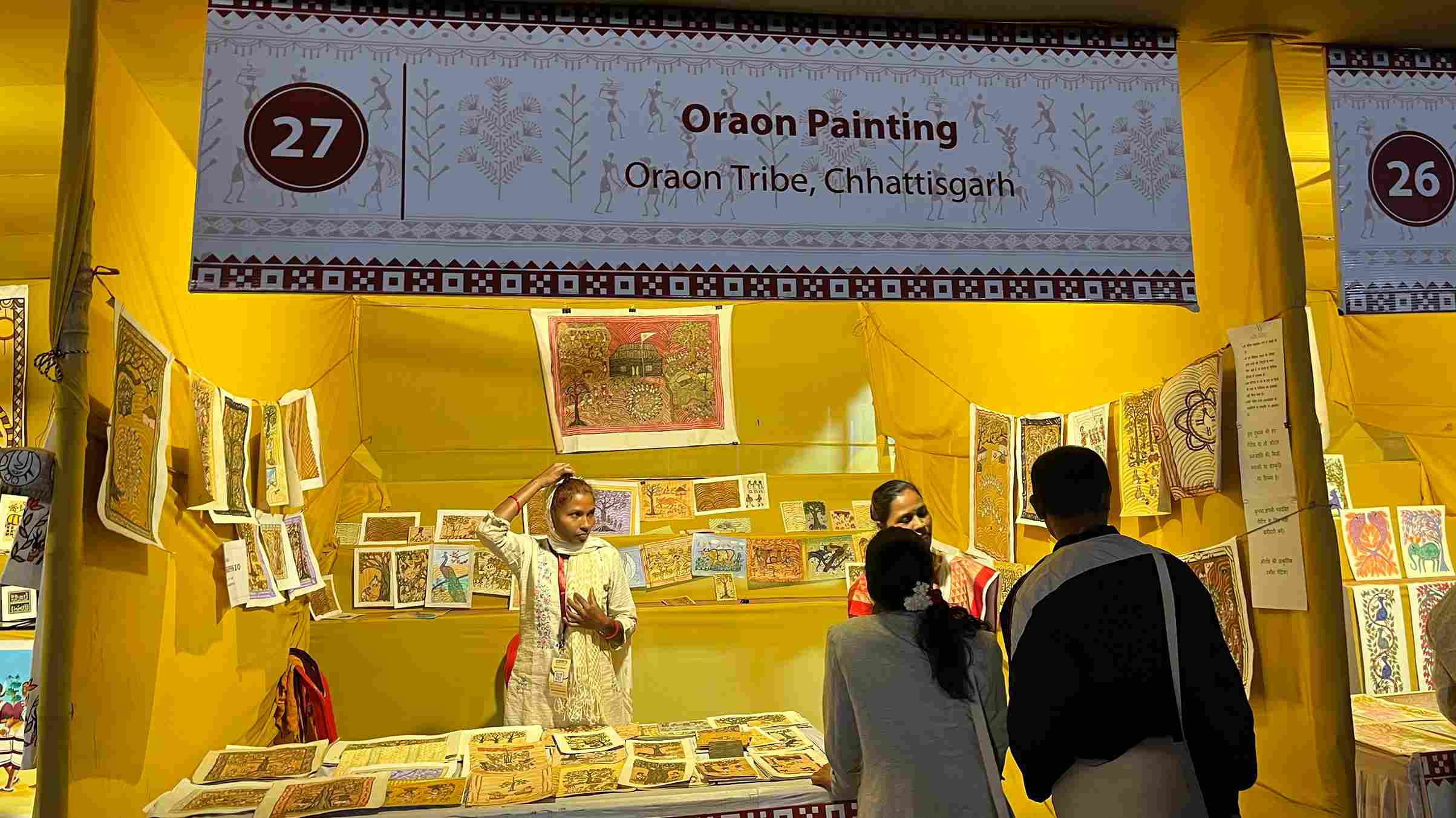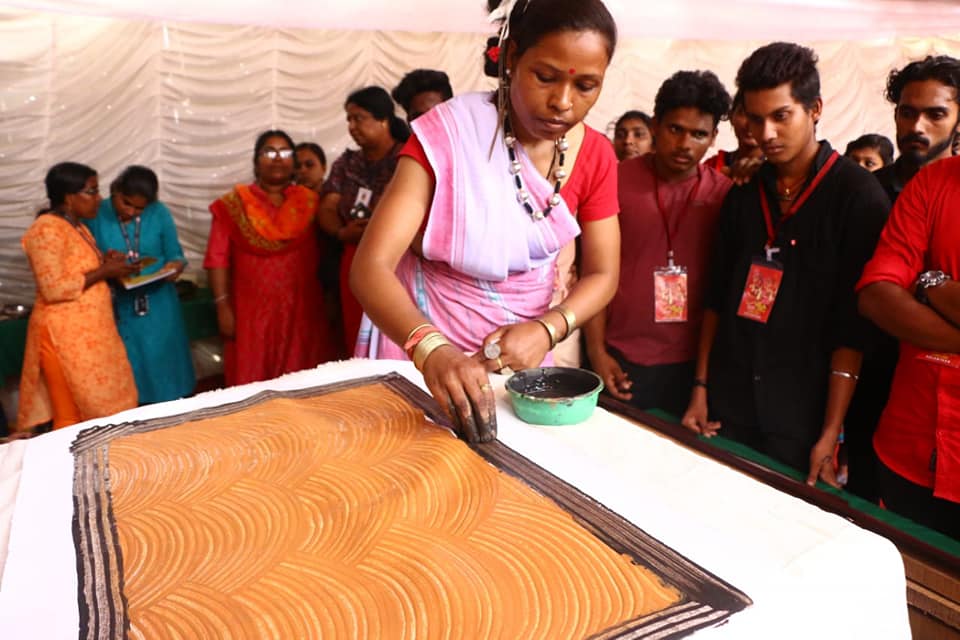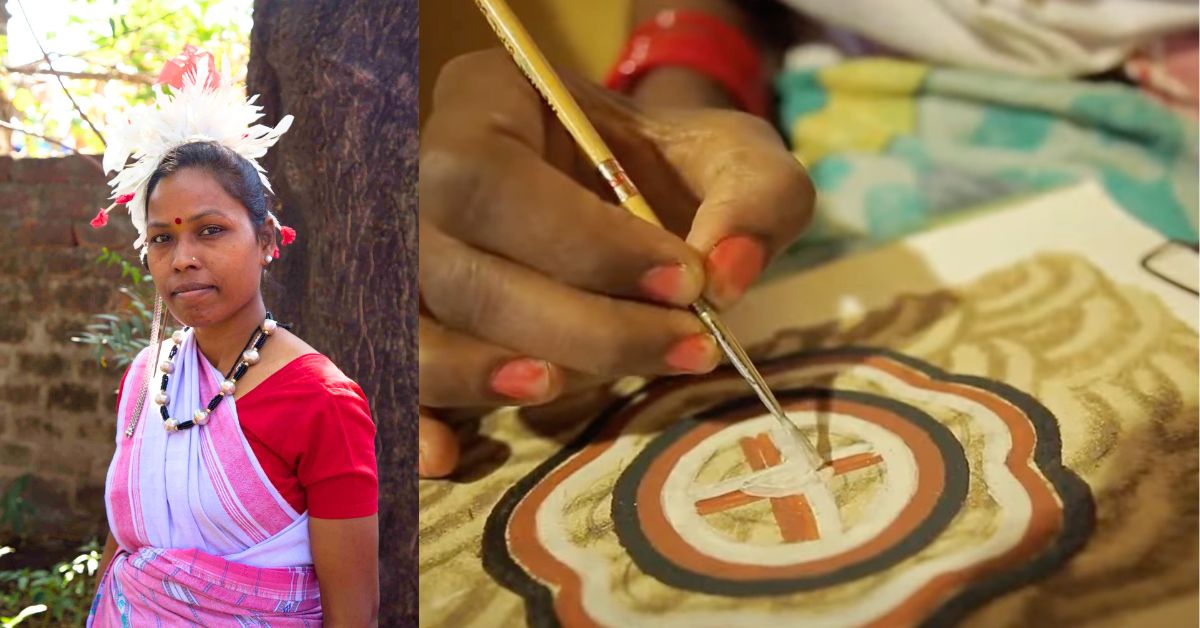This article has been published in partnership with Samvaad – Enabled by Tata Steel Foundation
On 15 November, 2023, Sumanti Devi, dressed in a red and white cotton saree, maintained a composed demeanour despite her excitement. With a job to fulfil and a role to embody, she concealed her feelings and prepared for the upcoming buzz at Jamshedpur’s Gopal Maidan.
“This is my tenth year of putting up a stall at Samvaad, and yet the jitters are very much there,” she told The Better India as she neatly placed Oraon paintings in her stall. She had carried more than 100 traditional paintings made by her and her family.
Sumanti works hard to preserve her community’s identity and culture through her involvement in Samvaad, an annual conclave organised by the Tata Steel Foundation (TSF).
For five days, Sumanti and 109 other artisans showcased their cultural heritage through diverse creations like hand-printed silks, textiles, woven fabrics, mud paintings, bamboo items, and traditional clothing stalls from 15 to 19 November, 2023. The theme for Samvaad 2023, ‘Walk with Me’, focused on the journey of ideas, collectives, and changemakers associated with Samvaad since its beginning.
Sadly, many of the artistic traditions in India are losing their relevance. While some communities are embracing modern methods like synthetic colours and brushes, others, like Sumanti, are steadfastly preserving their original techniques to safeguard these art forms.
“The next generation does not want to continue their artistic traditions as they are shifting to other sources of livelihood due to lack of proper remuneration. We are working on the revival of tribal art and craft,” Smita Verma, Lead – Gender & Community Enterprise at TSF, tells The Better India.

‘Mud and fingers are our USP’
There are no records of when Oraon paintings originated. Sumanti says the paintings are several centuries old and were passed down from one generation to another. She grew up seeing her family, relatives, and neighbours do Oraon painting on the walls on various occasions in the Jashpur district of Chhattisgarh.
“Calendars did not exist for me. I could tell which month or festival was coming up based on the painting my mother did on our house walls. For instance, people would draw the karam tree (Nauclea Parvifolia) ahead of the harvest festival. Drawing an egg in between rice grains meant Danda Kattna pooja for auspicious activities,” she shares.
The peculiar thing about Oraon paintings is that mud forms the main base due to the availability of various types of soils. The community creates different shades of black, brown and red from the soil. Green and white colours are made from leaves and rice respectively.
Sumanti says she adds glue to the colours so that it sticks to the canvas. To date, she and the people from her village have not used acrylic or synthetic colours.
She mentions two reasons for this, “Firstly, accessibility and cost came in the way, and secondly, natural colours are a very important part of our identity. Our ancestors were confined to villages, so they made natural colours on their own and took pride in them.”
Colours that come from the soil are seen as sacred, she informs. The elders of the house perform a brief ritual, praying for an obstacle-free search for the right soil. While red and brown soils were readily accessible, finding black ones was challenging at that time.
“Our ancestors would have to dig in forests to find the black soil. The rarity factor makes the soil so important in our culture. Besides, these three colours are used in all our pujas to date. According to a legend, Mahadev and Parvati ji told our ancestors to use these colours,” she shares.
Like colours, the primary themes also remain intact in the Oraon paintings. Mostly, the paintings depict community life — including their dance, customs, forest deities and festivals. The making can take up to 10 to 15 days due to the layered process. Each layer has to dry before the second layer is completed.
For all the paintings, Sumanti uses her fingers and cloth (for dabbing) even though the use of a brush is slowly penetrating the community, “But mud and fingers are our USP,” she says.
All these factors are what makes art so much more valuable and personal. The paintings do not preach or tell how one should live. Instead, it depicts Oraon’s culture most honestly.
“Art is a lifelong teacher. It has taught me to be fair towards myself and make the best of my circumstances. It is a reminder that despite the harshness of life, financial burdens, incomplete dreams and frustrated days, it is okay. Every time I paint, it shows me the genuine merit of life,” she shares.

Saving the fading art
Sumanti noticed migration and a decline in her village’s art over time. Her effort to take Oraon paintings to the popularity of Madhubani or Gond started 15 years ago. She pioneered the transition of these paintings from walls to cloth and handmade paper. Today, her artworks have journeyed across India, from Jammu and Kashmir, Maharashtra, and Chhattisgarh to Kerala.
“It started with a tribal art fair workshop in Bhubaneswar organised by Indira Gandhi Rashtriya Manav Sangrahalaya. We only sold one painting, but it gave us hope that if done correctly, it could be a viable option. A few years into doing exhibitions and local haats, I learnt about Samvaad. I joined the initiative as a fellow. As part of the fellowship, I released an art curation book titled ‘Evam Kala’ on Oraon folklore, documenting the culture and traditions,” says Sumanti, who has a master’s degree in political science.
She shares that she also attends handicraft and art workshops by Samvaad to learn about new market trends and skills that can help her with more sales.
“When you set up a stall in an exhibition, there is so much more than just selling the paintings. I learnt that if you wear traditional clothing in exhibitions, more people tend to visit your stall. The way you place your paintings in a small area also matters a lot. For example, always have a subtle and muted painting between two colourful paintings. It serves as a palette cleanser. Even the way you talk to people and tell your story matters. I learnt all this and more from experts who conduct Samvaad workshops,” Sumanti says.

Besides being an active participant in exhibitions, she is also passing on her skills to children.
“Along with telling the families in our village why Oraon paintings are important, I also tell them the financial perks and recognitions that come with it. I share with them the reasons why we have been making profits. I tell them that people, who have never heard about our tribe, like what we make! And it can be a lucrative career option. Several families are now either passing on the skills to their kids themselves or sending them to me for classes,” she adds.
Samvaad is a large gathering that includes over 200 tribal communities and brings together more than 2,500 people to celebrate tribal identity, art, healing practices, and culture.
(Edited by Pranita Bhat; All photos courtesy: Samvaad by Tata Steel Foundation)
No comments:
Post a Comment